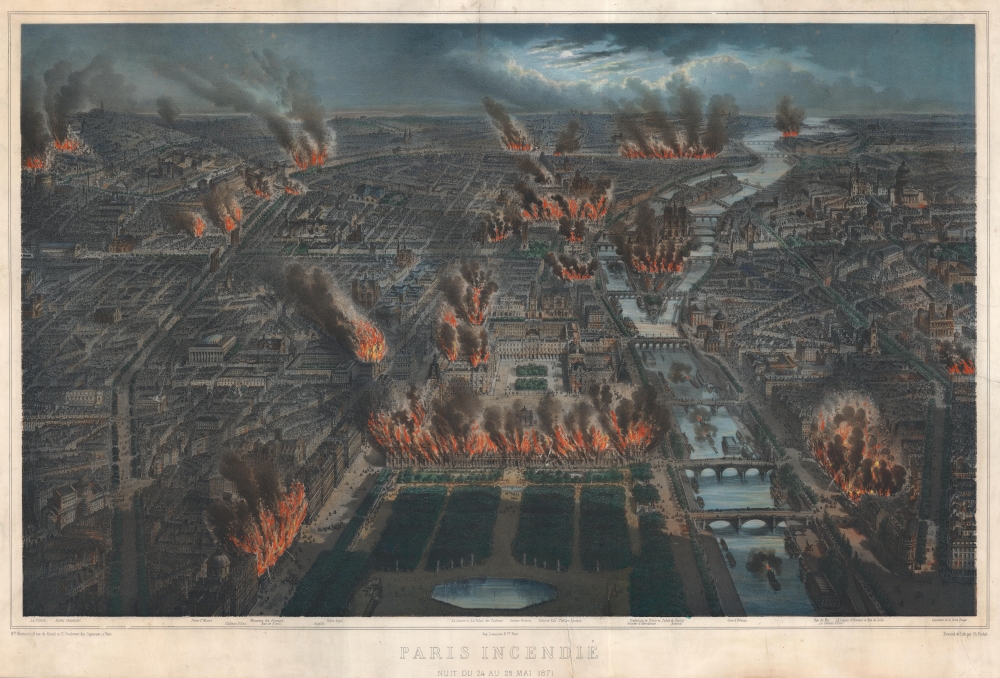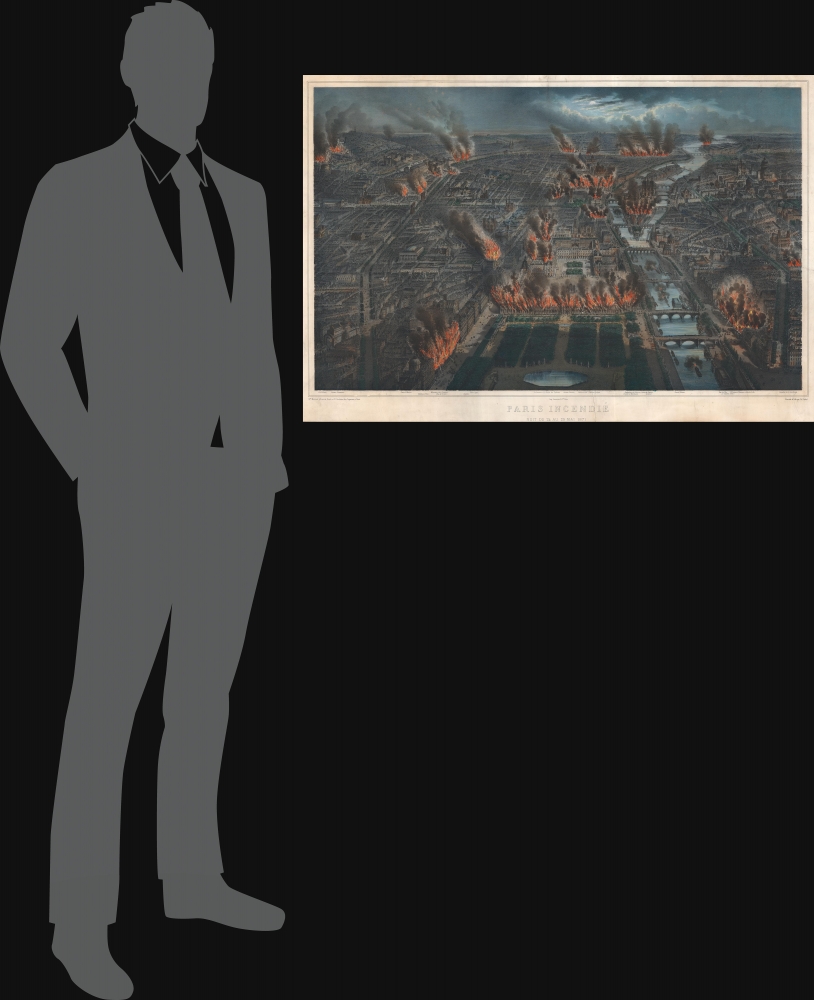1871 Fichot Bird's Eye View of Paris Burning during the Paris Commune
ParisIncendie-fichot-1871
Title
1871 (undated) 23.25 x 34 in (59.055 x 86.36 cm)
Description
A Closer Look
The view illustrates Paris from high above the Place de la Concorde, with a burning Palais des Tuileries front and center. The Arc de Triomphe du Carrousel (which still stands) and the Louvre are just behind the Tuileries. The left side of the Louvre is burning. To the left of the Louvre, fires burn along the Rue de Rivoli. To the right of the Louvre, across the Seine, the Palais d'Orsay and the Palais de la Legion d'honneur burn. In the background, the Hotel de Ville is engulfed in flames, while Notre Dame stands untouched. The Préfecture de Police burns in front of Notre Dame, but miraculously, the spire of the Sainte-Chapelle stands. (The Sainte-Chapelle was undamaged). Farther still in the background, fires burn near the Porte St. Martin and in La Villette. Gunboats navigate the Seine.The Paris Commune
The Paris Commune governed Paris from March 18, 1871 until May 28, 1871. It was a radical socialist, anti-religious, and revolutionary government that emerged from the chaos of the siege of Paris during the Franco-Prussian War. After controlling Paris for two months, the regular French Army suppressed the uprising in what has become known as La semaine sanglante ('The Bloody Week'). The semaine sanglante lasted from Sunday, May 21 - Sunday, May 28, 1871, and by the end of the week, French government troops had reconquered Paris. 6,667 Parisians were confirmed killed, but unconfirmed estimates place the death toll between 10,000 and 20,000.The Fires of the semaine sanglante
Members of the Commune began lighting fires around Paris on Monday night, May 22, starting with French army barracks on the Champ de Mars and the Finance Ministry. The following night, May 23, Commune members lit numerous monuments, including the Palais d'Orsay, the Palais de la Légion d'honneur, and the Palais des Tuileries (which burned until Friday, May 26 and appears front and center in this view). On May 24, the Louvre, the Palais-Royal, the Conciergerie, the Préfecture de Police, and the Théâtre-Lyrique were set ablaze, along with numerous private residences. The greatest destruction that day happened at the Hôtel de Ville (Paris' city hall), which was entirely destroyed along with the city's archives. It started raining on the afternoon of Friday, May 26, and poured the next day, putting out most of the fires. The destruction caused by the fires was widely documented in photographs and lithographs.Chromolithography
Chromolithography, sometimes called oleography, is a color lithographic technique developed in the mid-19th century. The process involved using multiple lithographic stones, one for each color, to yield a rich composite effect. Oftentimes, the process would start with a black base coat upon which subsequent colors were layered. Some chromolithographs used 30 or more separate lithographic stones to achieve the desired product. Chromolithograph color could also be effectively blended for even more dramatic results. The process became extremely popular in the late 19th and early 20th centuries when it emerged as the dominant method of color printing. The vivid color chromolithography produced made it exceptionally effective for advertising and propaganda imagery.Publication History and Census
This view was drawn and lithographed by Michel Charles Fichot, printed by Lemercier, and sold by Martinet c. 1871. We note only two cataloged examples, both of which are part of the collection at the Musée Carnavalet in Paris.CartographerS
Michel-Charles Fichot (June 6, 1817 - July 7, 1903) was a French artist, illustrator, painter, architect, and lithographer. Born in Troyes, he studied architecture at the École des Beaux-Arts in Paris. Fichot is responsible for hundreds of decorative prints, most city views and architectural views, and exhibited at the Paris Salon between 1841 and 1897. More by this mapmaker...
Rose-Joseph Lemercier (June 29, 1803 - 1887) was a French photographer, lithographer, and printer. One of the most important Parisian lithographers of the 19th century, Lemercier was born in Paris into a family of seventeen children. His father was a basket maker, and he even began working as a basket maker at the age of fifteen, but Lemercier was drawn to lithography and printing and soon entered into an apprenticeship with Langlumé, where he worked from 1822 until 1825. After working for a handful of other printers, Lemercier started his own firm in 1828 at 2, rue Pierre Sarrazin with only one printing press. He subsequently moved a few more times before arriving at 57, rue de Seine, where he founded the printing firm Lemercier and Company. He created the firm Lemercier, Bénard and Company in 1837 with Jean François Bénard. Lemercier bought out Bénard's share in the firm in 1843 and, since his two sons died at a young age, he decided to bring his nephew Alfred into the business beginning in 1862, who would progressively take on more and more responsibility in running the firm. Between 1850 and 1870, Lemercier's firm was the largest lithographic company in Paris. The firm began to decline in prestige in the early 1870s, and, after Lemercier's death in 1887, its descent only quickened. It is unclear when the firm closed, but Alfred directed the firm until his death in 1901. Learn More...




